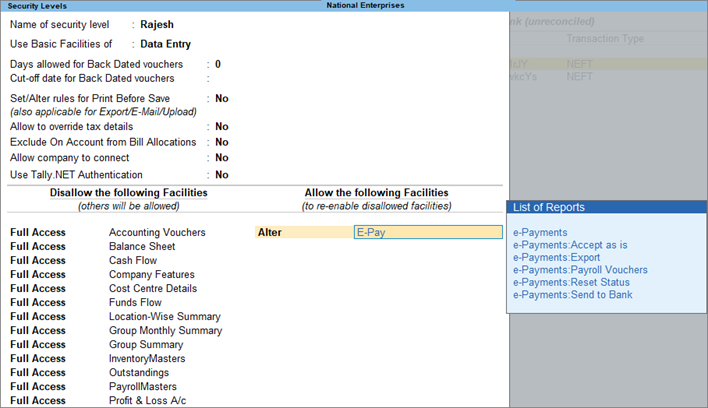e-Payments in TallyPrime
Using the e-Payments facility in TallyPrime, you can send payment instructions to the bank quickly and securely, without visiting the bank. To use e-Payment as a mode of payment you need to configure your bank ledger. You can record a payment voucher and select e-Payment as the mode of payment and later export the payment instructions which can be loaded to the bank portal. In TallyPrime, you can also reconcile your e-Payment transaction. The process of e-Payment reconciliation is also much simpler. Bank portals provide you with an intermediate/reverse file that records the status of your e-payments upload. You only have to import the intermediate file to TallyPrime, and TallyPrime will update the reconciliation status for you. You can view and track the status of your e-payment transactions using the e-Payments report and identify any incomplete information or mismatch in beneficiary details.
Apart from cheques, the most used payment mode is e-Payment in the business. e-Payment is a method of paying online or through an electronic medium. The most popular methods of e-Payment are Credit Cards, Debit Cards, UPI payments and so on. Online payment or e-Payment became popular as it improves the relationship with the suppliers due to the transparency, security and fast transfer of money. It also reduces the risk as Electronic payments are much more efficient and safe due to the multiple ways of securing your payments.
All the banking information and transactions that you maintain in TallyPrime are safe. However, you can provide additional security by authorising only certain users for e-Payments reports and operations. You can also create users with different levels of rights.
Configure Bank Ledger for e-Payments
To make the payments to the parties through online payment or e-Payment you need to enable e-Payments in your bank ledger. Once enabled you can configure the e-Payments option depending on the bank through which you have enabled the e-Payments facility. You can configure your Bank ledger for e-payments only for selected banks.
![]()
- Select the bank ledger.
- Press Alt+G (Go To) > Alter Master > type or select Ledger > and press Enter.
Alternatively, Gateway of Tally > Alter > type or select Ledger > and press Enter. - Select the bank ledger. For example, Kotak Mahindra Bank.
- Press Alt+G (Go To) > Alter Master > type or select Ledger > and press Enter.
- Enable e-Payment in bank ledger.
- In the Ledger Creation/Alteration screen for Bank Ledger, press F12 (Configure).
- Enable Set Bank Reconciliation and e-Payments.
- Press Ctrl+A to accept the screen.
- Configure e-Payments.
- In the bank ledger, under Bank Configuration, set Enable e-Payments as Yes.
The option Set/Alter e-Payments configuration appears. - Enable Set/Alter e-Payments configuration.
The configurations are applicable based on the bank that you select under Bank Name. The screen below displays the options applicable for e-Payments with Kotak Mahindra Bank.

- Update the configuration as required and press Ctrl+A to accept the screen.
- In the bank ledger, under Bank Configuration, set Enable e-Payments as Yes.
- As always, press Ctrl+A to accept the screen.
You can start recording payment vouchers with e-Payment as the mode of payment after you configure the bank ledger with the e-Payment option.
e-Payment Configuration
Different banks have different needs in e-payments, and TallyPrime allows you to configure these specific features in the respective bank ledger. The options appearing in the configuration depending on the bank ledger selected are shown below.
- Export/Upload Payment Instructions on voucher creation: This option allows you to export the payment instructions immediately after recording a payment voucher. If your bank account belongs to DBS, then this option allows you to directly upload the payment instructions to the bank portal. If you set this option to No, then you can export the required transactions from the e-Payments report.
- Allow export of transactions with mismatch in Bank Details: You can maintain the bank account details of a party in the party master. While recording a transaction, these account details will be automatically carried forward. You can also update these details during the transaction if required. Subsequently,
- If this option is set to Yes, then any mismatch in the bank account details will be ignored. The transaction will appear in the Ready for Sending to Bank section of the e-Payments report.
- If this option is set to No, then the transaction will appear in the Transactions with Mismatch in Bank Details (with Masters) section of the e-Payments report.
- Export payment file in encrypted format: This option will provide additional security for your e-payments. The exported files will be encrypted to prevent unauthorised modification. After enabling this option, you will have to specify the folder path where the encryption tool is located.
- Generate Payment Instructions in batches: This option allows you to export transactions in batches or groups. For example, you can export all your expense-related transactions or your party payments in specific batches and approve the respective batches on the bank portal.
- Specify Product Code based on: This option allows you to configure the Product Code based on the payment type (for vendor or employee payments) or voucher type/class (for contra, credit note, journal, and so on).
- Set/Alter output file name for Payment Instructions: This option allows you to configure the file name of the exported Payment Instructions. The file name consists of details such as the Customer Code and Format Code, which are provided by the bank. You can update these details if required.
- Format of Payment Instruction file for Export: You can select the format in which the payment instruction file has to be exported from the list of file formats. The existing (old format) is Fixed Width – Corporate Net Banking and the new format is Delimited (|) – Corporate Net Banking. Fixed Width would be set as default when your data is migrated and in the Export Payment Instruction screen, the File Format displayed would be Fixed Width for old and Delimited (|) for new.
- Folder Path for Payment Instructions: You can update the path where payment instructions will be exported if required. The default path will be set as per the path provided in Export Configuration.
- Folder Path for new Intermediate Files & Folder Path for imported Intermediate Files: For all the exported transactions, the bank portal will provide an intermediate (or reverse) file that records the reconciliation status. Accordingly, you can import this intermediate file to TallyPrime to reconcile your e-payment transactions.
In Folder Path for new Intermediate Files, you can specify the default path where you want to save the new intermediate files before importing them to TallyPrime.
In Folder Path for imported Intermediate Files, you can specify the default path where you want to save the intermediate files after export.
List of configurations supported by each bank.
|
Configuration
|
Supported Bank
|
|---|---|
| Export payment file in encrypted format |
Bank of Baroda (TallyPrime release 1.1.3 onwards) SCB (India), ICICI Bank, Citibank, |
| Export/Upload Payment Instructions on voucher creation |
DBS Bank (India), Standard Chartered Bank (India), Standard Chartered Bank (UAE), Kotak Mahindra Bank (India), YES Bank (India), ICICI Bank (India), Federal Bank (India), Tokyo & Mitsubishi (India), HDFC Bank (India), Citibank (India), RazorpayX (India), Bank of Baroda, Axis Bank (India), AU Small Finance Bank, IDFC First Bank, South Indian Bank (India), Bandhan Bank |
| Allow export of transactions with mismatch in Bank Details |
DBS Bank (India), Standard Chartered Bank (India), Standard Chartered Bank (UAE), Kotak Mahindra Bank (India), YES Bank (India), ICICI Bank (India), Federal Bank (India), Tokyo & Mitsubishi (India), HDFC Bank (India), Citibank (India), RazorpayX (India), Bank of Baroda, Axis Bank (India), AU Small Finance Bank, IDFC First Bank, South Indian Bank (India), Bandhan Bank |
| Folder Path for Payment Instructions |
DBS Bank (India), Standard Chartered Bank (India), Standard Chartered Bank (UAE), Kotak Mahindra Bank (India), YES Bank (India), ICICI Bank (India), Federal Bank (India), Tokyo & Mitsubishi (India), HDFC Bank (India), Citibank (India), RazorpayX (India), Bank of Baroda, Axis Bank (India), AU Small Finance Bank, IDFC First Bank, South Indian Bank (India), Bandhan Bank |
| Specify Product Code based on | HDFC Bank, Kotak Mahindra Bank, Bank of Baroda |
| Set/Alter output file name for Payment Instructions | ICICI Bank |
| Generate Payment Instructions in batches | Kotak Mahindra Bank |
| Folder Path for new Intermediate Files | SCB (India), HDFC Bank, Kotak Mahindra Bank, ICICI Bank, Bank of Baroda, RazorpayX (India), Axis Bank (India), Federal Bank (India), AU Small Finance Bank (India), South Indian Bank (India), Bandhan Bank |
| Folder Path for imported Intermediate Files | SCB (India), HDFC Bank, Kotak Mahindra Bank, ICICI Bank, Bank of Baroda, RazorpayX (India), Axis Bank (India), Federal Bank (India), AU Small Finance Bank (India), South Indian Bank (India), Bandhan Bank |
| Format of Payment Instruction file for Export | Yes Bank (TallyPrime Release 1.1.3 onwards) |
To know about the contact details of banks for e-Payments, click here.
Record e-Payment Transactions
Recording an e-Payment transaction is as easy as recording any other payment transaction. All you need to do is to select e-Payment as the mode of payment while recording the payment voucher. You can also make e-payments to your parties or the employees on your company’s payroll using the same simple steps. You must enable the option Export/Upload Payment Instructions on voucher creation in the e-payment configuration screen so that the Exporting Payment Instructions screen appears once the payment voucher is recorded.
- Record a payment voucher.
- Press Alt+G (Go To) > Create Voucher > press F5 (Payment) and press Enter.
Alternatively, Gateway of Tally > Vouchers> press F5(Payment) > and press Enter. - Debit the party ledger and credit the bank ledger that is configured for e-Payments.
- Press Alt+G (Go To) > Create Voucher > press F5 (Payment) and press Enter.
- Verify the e-Payments details.
- In the Bank Allocations screen, select e-Fund Transfer as the Transaction Type.
- Enter other details such as A/c No., IFS Code, Bank Name, Inst No., and so on if you have not maintained the beneficiary details in the party master.

- Press F12 (Configure) and set the option Show Ref ID to Yes if multiple beneficiary details are maintained.
The Ref ID column appears in the Bank Allocations screen. - Press Backspace to select the required beneficiary for the transaction.

- Press Ctrl+A to accept the Bank Allocations screen.
- Press Ctrl+A to save the payment voucher.
The Exporting Payment Instructions screen appears.
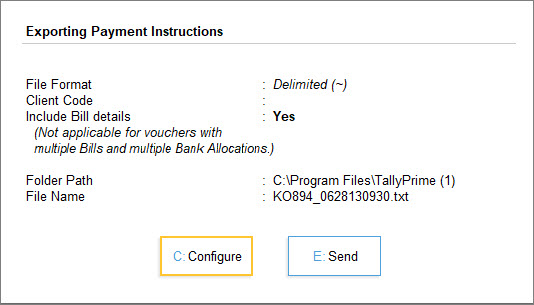
- Press C (Configure) to change the configurations or press E (Send) to export the details.
On successful export, the following message appears.
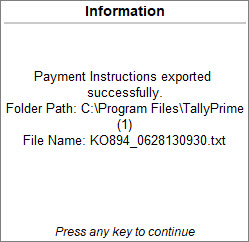
If beneficiary account details (like A/c No., IFS Code, and so on) are not provided in the ledger or during the transaction, or if there is a mismatch in the details, then the transaction will not be exported. You can find the transaction in the e-Payments report under the respective section.
-
For DBS, the transactions are directly uploaded to the bank portal, if you are logged in with the Tally.NET User ID that is registered with the bank. You can view the status in the e-Payments report and authorise the same on the bank portal.
- For other banks supported for e-payments, the transactions are exported locally. You can upload the exported transactions by logging in to the bank portal.
Export/Upload Payment Instructions to the Bank
Once your e-payment transactions are recorded, the payment instructions are ready to be uploaded to the bank portal. Before uploading, the e-Payments report in TallyPrime will help you in checking the transactions to ensure that the details are complete and error-free. If there are any errors, then you can drill down to the relevant section and update the details. Once you have cross-checked the details, you can proceed to export and upload the payment instructions to the bank. You also have the option to provide additional security for your payment instructions by encrypting the exported files. This encryption is valid for ICICI Bank, Standard Chartered Bank (India), Citi Bank and Bank of Baroda.
Note: For ICICI Bank: Encryption is mandatory to upload the exported files to the bank portal. The encryption tool has to be taken from your ICICI Bank RM. If you want to encrypt the files directly in TallyPrime, use the tool ICICI_WEH128. To encrypt the file outside TallyPrime, use ICICI_AES128_Encryptor.
For Citibank: Since the encryption tool is external which the customer has to procure, please contact your Citibank RM with this regard.
You can upload either a single transaction or multiple transactions at the same time. Single transactions can be uploaded directly during voucher entry, as shown in the e-Payment Transactions section.
Once the transactions are processed from the bank, you can download the intermediate file to update the status of the completed transactions. This is supported by Kotak Bank, ICICI Bank, Standard Chartered Bank, HDFC Bank, Bank of Baroda, Axis Bank, RazorpayX and AU Small Finance Bank.
To export payment instructions for multiple payments.
- Press Alt+G (Go To) > type or select e-Payments > press Enter.
Alternatively, Gateway of Tally > Banking > e-Payments. - Select the required bank column for the Ready for Sending to Bank section, and press Enter.
The e-Payments screen for the selected bank appears, as shown below:

- Select the transactions that you want to export, and press Alt+E (Export) > Payment Instructions.
The Exporting Payment Instructions screen appears as shown below:

- Press C (Configure) to change the configurations or press E (Send) to export the details.
You can now log in to your bank portal to upload the exported output file from your local system.
e-Payments Report
The e-Payments report in TallyPrime provide you with a clear picture of all your e-payment transactions. You can view and track the status of your e-payment transactions, and identify any incomplete information or mismatch in beneficiary details. You can view the e-payments that are sent (or ready to be sent) to the bank. You can also view the bank balance as per the company’s books and compare it with the balance as per the bank.
In the case of DBS (India), you can open the bank portal directly from the e-Payments report.
In this section
- View e-Payments Report
- Transactions recorded with incomplete bank details
- Transactions with Mismatch in Bank Details (with Master)
- Transactions Sent to Bank (Unreconciled)
- Bank balance as per company books
View e-Payments Report
The default view of the e-Payment report displays the list of errors for which the payment instruction is not generated along with the count of transactions and the amount. If you have transactions in multiple bank ledgers then all the bank ledgers are shown in multiple columns together with the transaction count and amount. Apart from the error list, you can also see the list of transactions that were sent to the bank but it is not yet reconciled and also the list of transactions that are ready to be sent to the bank.
- Press Alt+G (Go To) > type or select e-Payments > press Enter.
Alternatively, Gateway of Tally > Banking > e-Payments > press Enter.

The transactions displayed in the report include vendor payments or payroll payments, or both, according to your business type. You can include or exclude the payroll transactions by pressing F8 (Exclude Payroll).
If you have already sent the list of transactions to the bank, then you can include exported or processed transactions by pressing Ctrl+B (Basis of Values) > enable Include Exported/Processed transactions.
Transactions recorded with incomplete bank details
The Transactions with Incomplete Bank Details section displays transactions in which certain mandatory bank details (such as A/c No. and IFS Code) were not specified for e-Fund Transfer. You can select the transaction and provide the required information and then the transactions will be ready to be sent to the bank. You can also choose to add the same details to the party master.
- Press Alt+G (Go To) > type or select e-Payments > press Enter.
Alternatively, Gateway of Tally > Banking > e-Payments > press Enter. - Drill down from the required bank column for the Transactions with Incomplete Bank Details section, as shown below:

- Press Alt+H (Exclude) to exclude the transaction or press Enter to view the Bank Details screen.
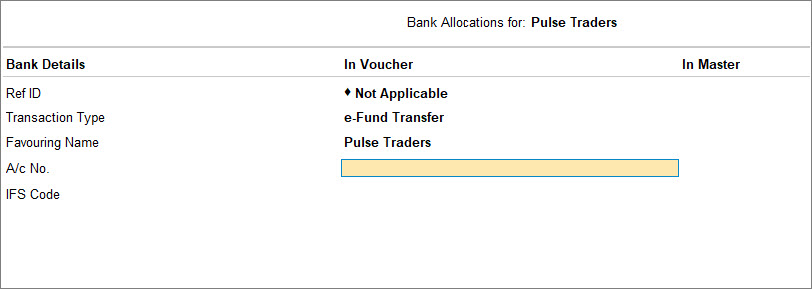
- Provide the missing information, or press Alt+S (Copy Master Info.) to copy the bank details from the master to the voucher.
While saving the details, you can do one of the following:
- Press A to accept the transaction with the information you entered.
- Press R to replace the master details with the bank details specified in the voucher. The R: Replace button appears if bank details have been specified in the master.
- Press D to accept the transaction and also update your master ledger. This option will not appear while you are copying the details from the master.
- Press B to make any changes in the Bank Details (Voucher) section.
Once the details are updated the transaction moves to the Ready for sending to bank section.
Transactions with Mismatch in Bank Details (with Masters)
When the bank details specified in a transaction do not match with the bank details specified in the party master, the transaction will be listed under Transactions with Mismatch in Bank Details (with Masters) in the e-Payments report. You can copy the information from the master to the voucher directly from the e-Payments report. You can accept the details in the master or press Alt+J (Accept as is) to accept the modified bank details.
- Press Alt+G (Go To) > type or select e-Payments > press Enter.
Alternatively, Gateway of Tally > Banking > e-Payments > press Enter. - Drill down from the required bank column for the Transactions with Mismatch in Bank Details (with Masters) section. The following screen appears:

- Press Alt+H (Exclude) to exclude the transaction, press Alt+J (Accept as is) or press Enter to view the Bank Details screen.

- Press Alt+S (Copy Master Info.) to copy the bank details from the master to the voucher.
- Press Enter to accept the bank details as per the master. This will ensure that the bank details are the same as the bank details entered in the bank ledger master.
Once completed, the selected transaction moves to the Ready for sending to bank section.
Transactions Sent to Bank (Unreconciled)
The e-Payments report also displays transactions that have been already sent to the bank, but are yet to be reconciled, under the Transactions Sent to Bank (Unreconciled) section. You can check the status of the transactions and import the intermediate/reverse file to update the status. In the case of DBS, press Alt+R (Update Status) to refresh the status.
- Press Alt+G (Go To) > type or select e-Payments > press Enter.
Alternatively, Gateway of Tally > Banking > e-Payments > press Enter. - Drill down from the required bank column for the Transactions Sent to Bank (Unreconciled) section.
- Press Enter. The e-Payments screen for the bank appears with the status of each of the transactions, as shown below:

- Press F5 (Refresh) to view the updated status of the transactions.
Re-export transactions to bank | Reset Status
The Transactions Sent to Bank (Unreconciled) section also provides you with the option to reset the status of your exported transactions and reconsider them for e-payments. For instance, you might have exported the transaction already, but the file is lost or damaged. In such cases, you can reset the status of the transaction and re-export it to the bank portal. You only have to select the transaction and press Alt+S (Reset Status). The transaction will be reconsidered for e-payments and included in the relevant section.
For DBS transactions, one of the following statuses may appear:
- Submitted – When transactions are sent to the bank.
- Verifying – When transactions are under verification by the bank.
- Authorisation pending – When transactions have been accepted by the bank and are available for authorisation on the bank portal.
- Authorised – When transactions are authorised on the bank portal.
- Processed – When transactions are processed by the bank.
- Failed – When transactions have failed due to incorrect sender A/c no., invalid IFS code, unregistered TSS ID with the bank, and so on.
Bank Balance as per Company Books
In the e-Payments report, the Bank Balance as per Company Books section reflects the balance as of the last date.
- Press Alt+G (Go To) > type or select e-Payments > press Enter.
Alternatively, Gateway of Tally > Banking > e-Payments > press Enter. - Drill down from Bank Balance as per Company Books to view all your unreconciled vouchers in one place.

You can view the transactions that were excluded from the e-payment process, by pressing Alt+H (Show Included). If you want to include the transaction in the e-payment process, then select the transaction and press Alt+S (Reset Status). The transaction will be considered for e-payments and included in the relevant section.
e-Payment Reconciliation
Reconciliation of e-payments is necessary to detect any differences between the bank balance as per the company’s books and the bank balance as per the statement supplied by the bank for e-payments.
TallyPrime is here to simplify reconciliation for you. You only have to import the intermediate file in TallyPrime, and, based on the status in the file, TallyPrime will reconcile your e-payment transactions. You can find further details of reconciliation in the e-Payments report <hyperlink to e-Payments report>
- Open e-Payment report.
- Press Alt+G (Go To) > type or select e-Payments > press Enter.
Alternatively, Gateway of Tally > Banking > e-Payments > press Enter.
- Press Alt+G (Go To) > type or select e-Payments > press Enter.
- Drill down from the Transactions Sent to Bank (Unreconciled) section.
- Import Intermediate File.
- Press Alt+O (Import) > Intermediate File.
The Import Intermediate File screen appears.

- Select the File Path and File to Import (Delimited), and press Enter.

The following success message will appear after the file is imported. These transactions will be reconciled with the updated Bank Date and Inst No.
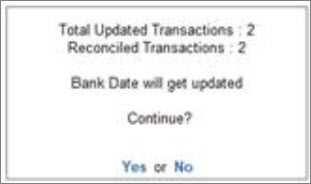
- Press Alt+O (Import) > Intermediate File.
Refer to the Bank Reconciliation article to know more about Bank Reconciliation in general.
Security for e-Payments
You can provide additional security for your banking details and e-payments by creating users with special rights and authorising them for specific operations. You can use the Security Control feature to set up the required security levels. For example, if you want your data entry operator to have access only for e-Payments related reports, then you can allow full access or access to alter for the List of Reports related to e-Payments.
- Press Alt+K (Company) > User Roles.
- Select the security level (for example, Data Entry) from the List of Security Levels, and press Enter.
- Accept the security settings. As always, you can press Ctrl+A to save the screen.
Refer to the Manage Users article for more information on Security Control.

